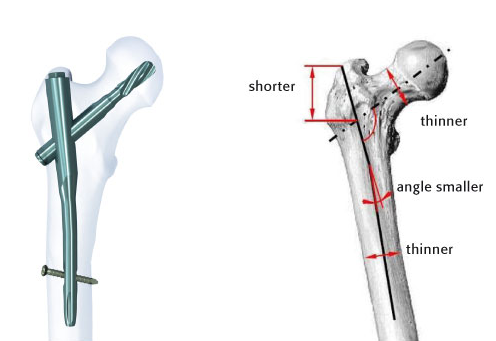What is DHS and DCS?
DHS (Dynamic Hip Screw) is a surgical implant used primarily for the treatment of femoral neck fractures and intertrochanteric fractures. It consists of a screw and a plate system that provides stable fixation by allowing dynamic compression at the fracture site, promoting healing.
DCS (Dynamic Condylar Screw) is a fixation device used for fractures of the distal femur and proximal tibia. It combines the benefits of both multiple cannulated screws (MCS) and DHS implants, providing controlled dynamic compression through three screws arranged in an inverted triangular configuration.
What is the Difference Between the DHS and the DCS?
DHS (Dynamic Hip Screw) is primarily used for femoral neck and intertrochanteric fractures, providing stable fixation with a screw and plate system. DCS (Dynamic Condylar Screw) is designed for distal femur and proximal tibia fractures, offering controlled dynamic compression through a triangular screw configuration.
What is a DCS Used For?
DCS is used for the treatment of fractures in the distal femur and proximal tibia. It is particularly effective in providing stability and promoting healing in these areas by applying controlled dynamic compression at the fracture site.
What is the Difference Between DCS and DPL?
DPL (Dynamic Pressure Locking) is another type of fixation system used in orthopedic surgery. While both DCS and DPL aim to provide stable fixation for fractures, DPL typically uses locking screws and plates to achieve rigid fixation, whereas DCS focuses on dynamic compression to enhance fracture healing.
What is the Difference Between DPS and CPS?
DPS (Dynamic Plate System) and CPS (Compression Plate System) are both used for fracture fixation. DPS allows for dynamic compression, which can enhance fracture healing by promoting interfragmentary movement during weight-bearing. CPS, on the other hand, provides static compression and is used for more stable fractures where dynamic compression is not necessary.
What is the Difference Between DCS 1 and DCS 2?
DCS 1 and DCS 2 refer to different generations or configurations of the Dynamic Condylar Screw system. DCS 2 may offer improvements in terms of design, material, or surgical technique compared to DCS 1. However, specific differences would depend on the manufacturer’s updates and advancements in the system.
How to Do a DHS?
DHS is a surgical procedure used to treat fractures of the proximal femur, including intertrochanteric and subtrochanteric fractures. The procedure involves the following steps:
1.Preoperative Preparation: The patient is evaluated thoroughly, and the fracture is classified using imaging studies such as X-rays.
2.Anesthesia: General anesthesia or regional anesthesia (e.g., spinal anesthesia) is administered.
3.Incision and Exposure: A lateral incision is made over the hip, and the muscles are retracted to expose the femur.
4.Reduction and Fixation: The fracture is reduced (aligned) under fluoroscopic guidance. A large cancellous screw (the lag screw) is inserted into the femoral neck and head. This screw is housed within a metal sleeve, which is attached to a plate that is fixed to the lateral femoral cortex with screws. The DHS allows for dynamic compression, meaning the screw can slide within the sleeve, promoting fracture compression and healing.
5.Closure: The incision is closed in layers, and drains may be placed to prevent hematoma formation.
What is PFN Surgery?
PFN (Proximal Femoral Nail) surgery is another method used to treat proximal femoral fractures. It involves the insertion of an intramedullary nail into the femoral canal, which provides stable fixation from within the bone.
What is the Z Phenomenon in PFN?
The “Z phenomenon” in PFN refers to a potential complication where the nail, due to its design and the forces applied, can cause varus collapse of the femoral neck. This can lead to malalignment and poor functional outcomes. It occurs when the nail’s geometry and the forces exerted during weight-bearing cause the nail to migrate or deform, leading to a characteristic “Z” shape deformation in the nail.
Which is Better: Intramedullary Nail or Dynamic Hip Screw?
The choice between an intramedullary nail (such as PFN) and a Dynamic Hip Screw (DHS) depends on several factors, including the type of fracture, bone quality, and patient characteristics. Studies have shown that PFN generally offers certain advantages:
1.Reduced Blood Loss: PFN surgery typically results in less intraoperative blood loss compared to DHS.
2.Shorter Surgery Time: PFN procedures are often quicker, reducing the time under anesthesia.
3.Early Mobilization: Patients treated with PFN can often mobilize and bear weight earlier, leading to a quicker recovery.
4.Reduced Complications: PFN has been associated with fewer complications, such as infection and malunion.
However, DHS remains a viable option, especially for certain types of stable fractures where its design can provide effective fixation. The decision should be made based on individual patient needs and the surgeon’s expertise.
Can PFN Be Removed?
In most cases, the PFN (Proximal Femoral Nail) does not need to be removed once the fracture has healed. However, removal may be considered if the patient experiences discomfort or complications related to the implant. The decision to remove the PFN should be made in consultation with the treating orthopedic surgeon, considering factors such as the patient’s overall health and the potential risks and benefits of the removal procedure.
Post time: Apr-19-2025












